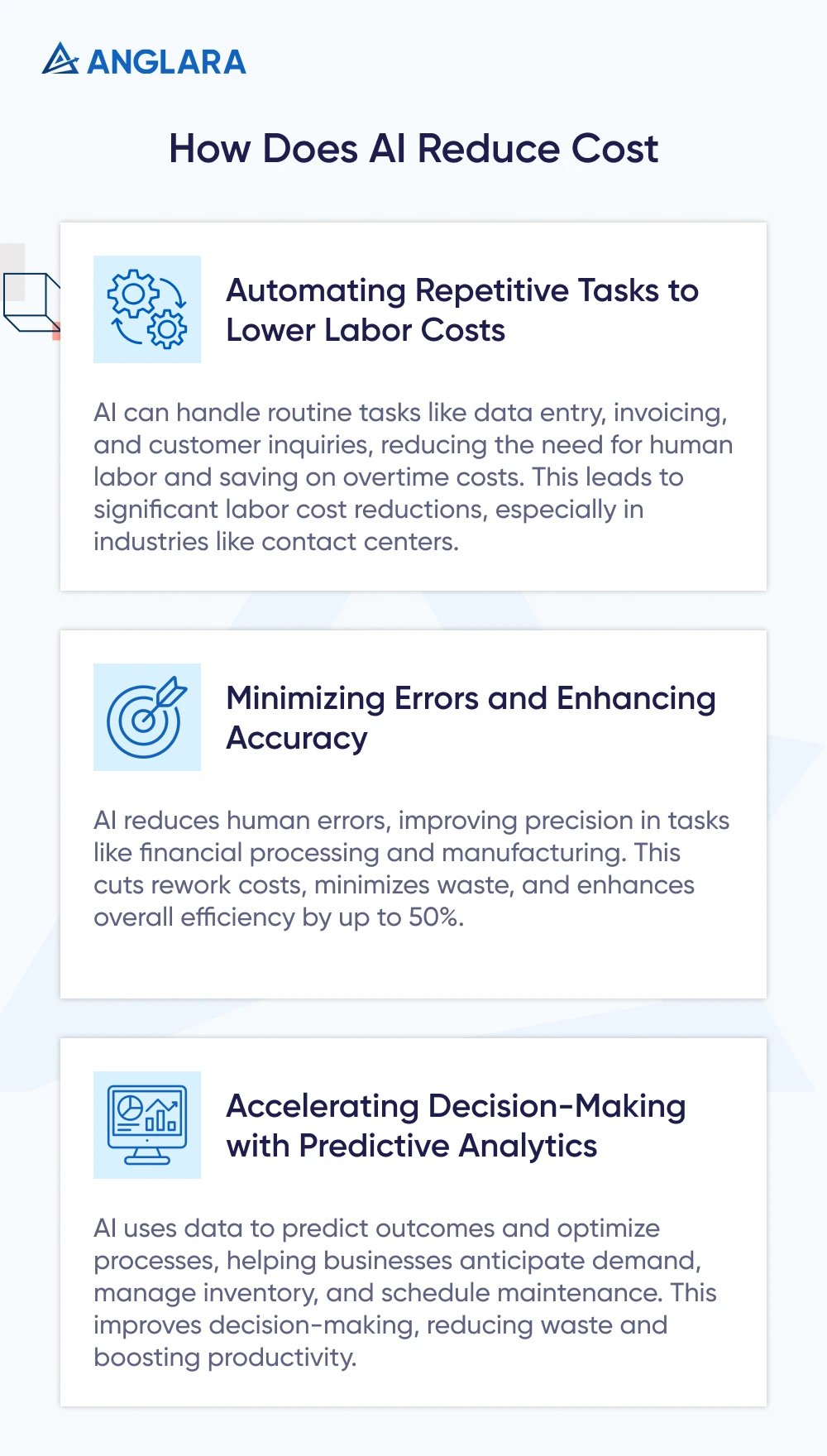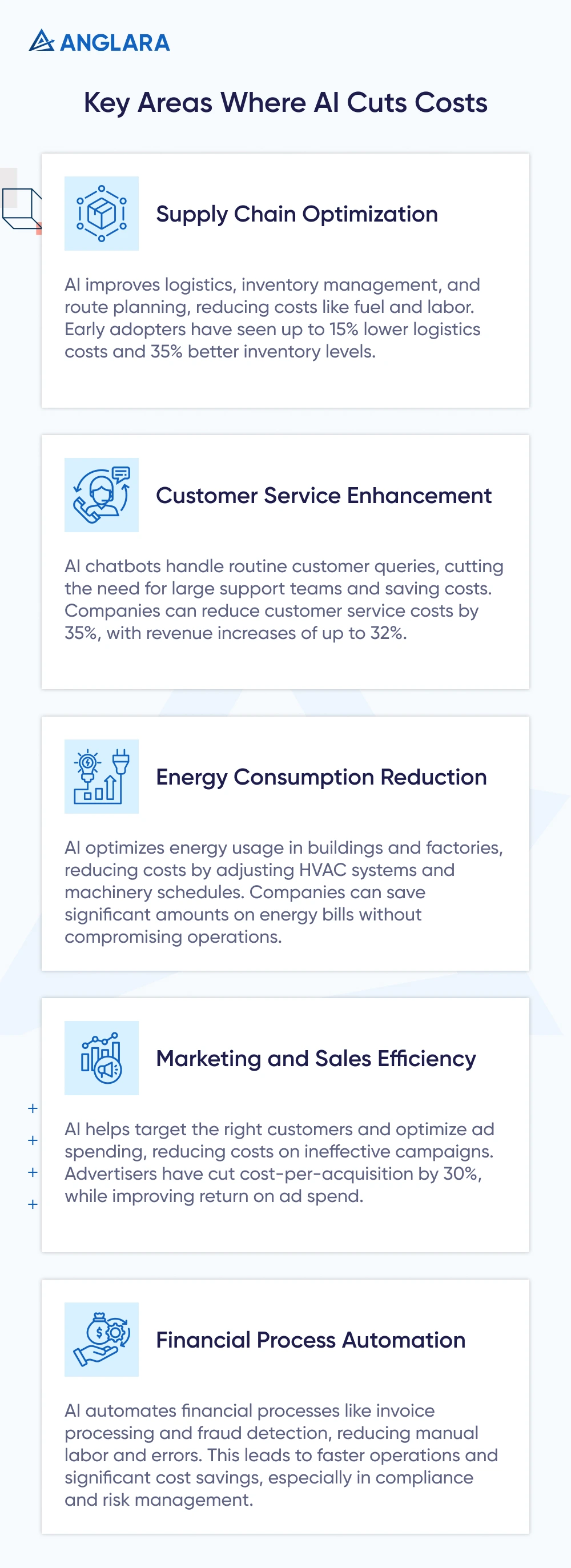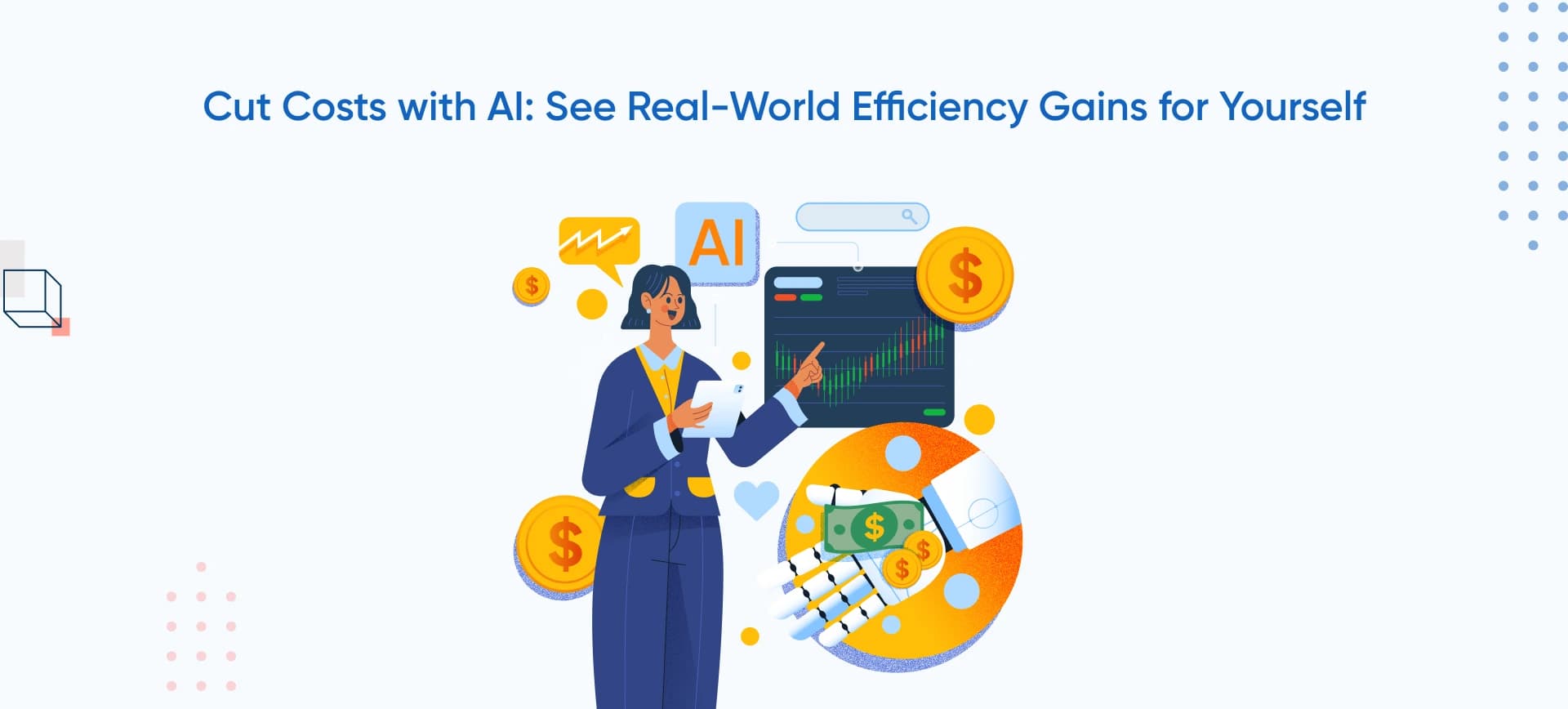Businesses all around the world claim to be implementing AI to cut operational expenses, boost efficiency, and maximize profit. But how?
You landed here because you’re wondering how does AI reduces cost and affects your bottom line, and we’ve got the answer to this throbbing question.
From automating tedious back-office work to slashing error rates and helping leaders make smarter decisions faster, AI unlocks cost savings at nearly every level of the enterprise. In today’s competitive market, adopting AI isn’t just about staying ahead; it’s about making your business leaner, stronger, and ready for what’s next.
We break down how AI delivers real, measurable cost reductions. And as an added bonus, we’ll also tell you the steps to implement and start seeing results.
Read on!
How does AI reduce cost
AI is no longer just a futuristic promise; it’s a real driver of cost savings for global businesses today. By embedding artificial intelligence across key operations, companies can unlock new efficiencies, cut unnecessary expenses, and sharpen their competitive edge.
Let’s break down exactly how AI reduces costs in practice.

Automating repetitive tasks to lower labor costs
AI can take over routine, repetitive work from data entry and document processing to simple customer inquiries, freeing human workers for higher-value tasks.
For example, chatbots and robotic process automation (RPA) handle support tickets, scheduling, invoicing, and more without breaks. A finance team can also deploy AI bots to reconcile invoices and accounts, categorize expenses, and flag anomalies in seconds.
An AI system can automate processes that might take a human worker hours of manual labor, if not days, thereby saving on overtime pay and speeding up month-end closing.
This automation directly lowers labor expenses.
In contact centers, for instance, AI-powered tools already reduce operational workload and costs dramatically. A recent industry report noted that about 43% of contact centers use AI, leading to roughly a 30% reduction in operational costs.
In practice, this means fewer full-time staff hours are needed for routine jobs. Over time, labor savings from automated tasks can add up to millions for large organizations.
Minimizing errors and enhancing accuracy
Human errors like typos, miscalculations, and misplaced data can be costly. They lead to rework, wasted materials, customer returns, and compliance fines.
AI excels at tasks requiring precision and consistency. Industry reports suggest AI can cut error-related rework by 50%, boosting overall efficiency by as much as 30–50%.
For instance, AI algorithms used in financial processing or quality inspection spot mistakes far more reliably than humans. By cutting error rates, AI reduces costs associated with redoing work or correcting mistakes.
In manufacturing, AI quality-control cameras detect defects on assembly lines, preventing faulty products from shipping and saving repair costs. In healthcare, AI systems can catch prescription or billing errors before they harm patients or trigger insurance losses.
Overall, enhanced accuracy means less waste of time and fewer surprises on the balance sheet.
Minimizing errors and enhancing accuracy
Faster, smarter decisions also drive cost savings. AI-powered predictive analytics can sift through mountains of data, such as market trends, inventory levels, and consumer behavior, to forecast outcomes and recommend actions.
This means businesses can anticipate demand, optimize pricing, and allocate resources before problems arise. For example, a retailer using AI demand forecasting might reduce stockouts and overstocks, avoiding the costs of lost sales and markdowns. Or a factory using AI-based scheduling can minimize downtime by predicting when equipment needs maintenance.
In short, AI speeds up insights and reduces “guesswork” so companies make better choices quickly. The result is leaner operations with lower waste and higher productivity.
Key areas where AI cuts costs
AI isn’t just limited to one department, but it delivers savings across your entire business. From logistics and customer service to marketing, energy management, and finance, the impact of AI is both broad and deep.
Here are some of the key areas where AI can dramatically reduce costs and boost your bottom line.

Supply chain optimization
Supply chains are complex and traditionally a major source of costs in managing logistics, inventory holding, etc. AI can optimize every link in the chain. For example, AI demand forecasting predicts what products customers will need and when, so you can reduce excess inventory and avoid stockouts. AI route-planning optimizes delivery paths to cut fuel and labor costs.
McKinsey found that early adopters of AI in supply-chain management achieved impressive results with 15% lower logistics costs, 35% better inventory levels, and 65% improved service levels.
In practice, this means that using AI can turn excess warehouse space and late shipments into lean, reliable operations.
Customer service enhancement
Customer support often involves high staffing and training costs. AI-powered chatbots and virtual assistants can handle routine questions like order status, FAQs, and basic troubleshooting around the clock.
This reduces the need for large call centers or 24/7 staffing and ensures instant response to customer queries. In retail or banking, companies save millions by routing simple service requests to bots. Happy customers get instant answers, and the company spends far less on human support. Even complex queries can be pre-screened by AI, letting human agents focus only on the hardest cases.
The cost savings with AI in customer service can be substantial. McKinsey reports a 35% cost reduction and a 32% revenue increase with the adoption of AI. AI chatbots will save businesses billions of dollars, with a Juniper Research study forecasting ~$11 billion in savings for retail, banking, and healthcare by 2023 through chatbot deployment.
Energy consumption reduction
Energy is a major cost for many businesses, from manufacturing to IT operations. AI can trim energy bills through smart management.
Let’s take an example of AI-driven building management systems that adjust HVAC, lighting, and machinery schedules to match actual needs. Over 11 months, it cut HVAC energy use by 15.8%, saving about $42,000 while reducing CO₂ emissions.
Across a portfolio of facilities, such savings compound. Data centers also use AI to optimize cooling, with Google’s DeepMind famously cutting data-center energy use by 15%. In factories, AI predicts exactly when machines need power and when they can idle, cutting peak consumption.
Ultimately, AI helps companies pay much less for electricity and fuel without sacrificing comfort or output.
Marketing and sales efficiency
Marketing and sales departments stand to save a lot by using AI for targeting and personalization. AI analyzes customer data to find who is most likely to buy, which channels work best, and how much to bid for ads.
This means you waste less on uninterested audiences.
Several instances prove that advertisers using Google’s AI-powered bidding cut cost-per-acquisition by about 30% compared to manual methods. Adore Me, an intimate clothing e-commerce brand, reduced customer acquisition costs by 15–20% while boosting return on ad spend by 30% after adding AI to their ad targeting.
AI also upsells smarter and personalizes offers, leading to higher conversion rates and lifetime customer value. In sum, marketing budgets go further because AI stops money from leaking out on ineffective campaigns.
Financial process automation
Banking and finance teams deal with massive paperwork and routine processes related to accounting, compliance, claims, etc. AI streamlines these tasks and helps minimize costs.
Take automated invoice processing and fraud detection, for example. They eliminate hours of manual review each day. In 2023, Juniper Research estimated that banks could save around $900 million by 2028 by applying AI to identity verification. It’s faster, reduces the need to hire more people, and offers consistent reliability by helping institutions avoid human errors and negligence.
Overall, financial operations become faster and require fewer full-time staff, driving huge cost savings in administration and risk management.
Real-world examples of AI-driven cost savings
AI is already delivering measurable savings for major brands and fast-growing startups alike. From finance and healthcare to retail and tech, these real-world examples show how AI adoption translates directly into saving big bucks, boosting productivity, and unlocking new opportunities.
Keep reading for examples of how forward-thinking organizations are using AI to cut costs and gain a serious competitive edge.
JPMorgan Chase
JPMorgan Chase has invested heavily in AI to cut costs in back-office operations. Its “COIN” (Contract Intelligence) system uses machine learning to review legal documents and loan agreements.
What once took human lawyers thousands of hours can now be done in seconds. In fact, JPMorgan reports that COIN saved the bank 360,000 hours of work in one year, the equivalent of over 41 years of nonstop legal labor.
By automating this once-manual work, JPMorgan dramatically reduced staffing costs in its legal and loan departments while also improving accuracy. This shows how even traditional financial firms can reap big savings: AI did in minutes what used to take people weeks.
John Muir Health
In healthcare, John Muir Health, a California health system, adopted an AI-powered ambient listening tool as a medical scribe to help doctors with charting. This eased physician burden and reduced burnout, which translated directly into cost savings.
Since deploying the system, John Muir estimates about $3 million in savings from lower physician turnover. Reduced turnover means fewer expensive recruitments and better care continuity. This example highlights the potential benefits of AI in healthcare: Artificial intelligence can cut administrative costs and labor churn.
Amazon
Amazon is one of the biggest adopters of AI in retail logistics. It has deployed hundreds of thousands of robots powered by agentic AI across its warehouses to unload trailers, retrieve parts for repairs, etc.. It also uses AI for inventory forecasting and route optimization in delivery. The net effect of AI adoption is not only massive cost avoidance on everything from warehousing to shipping, but also significant minimization in waste and carbon emissions.
Analysts at Morgan Stanley project that Amazon’s robotics alone could save the company about $10 billion per year by 2030. These robots help pick, pack, and sort packages far faster than humans, slashing labor costs and error rates. By 2030, Amazon expects a 25% improvement in fulfillment costs at its “next-generation” warehouse in Louisiana, showing how quickly those savings add up.
StoryAI
A storytelling app case study, developed by Anglara, leverages AI to generate personalized, interactive stories for users, drastically reducing content creation costs for the startup. Instead of hiring a large team of writers, the company used generative AI models to build engaging stories at scale, with each user receiving a unique narrative experience.
By using the AI approach, content creation companies can cut content production costs and channel their resources to product development and user experience. The AI engine not only lowers operational expenses but also enables rapid iteration and new story features without the need for constant manual input.
See the app’s design concept here.
RecipeAI
Another creative application built by Anglara for the food tech sector is an AI-powered recipe app that generates custom meal ideas based on user preferences.
Rather than maintaining a vast human editorial team, the platform relies on AI to suggest recipes, plan meals, and even generate shopping lists. This drastically lowers labor and research costs.
By automating recipe creation, the company saves time and money and delivers fresh, personalized content daily. As a result, they can scale their user base and offerings without ballooning expenses.
Explore the UI concept here.
Implementing AI for cost reduction in your business
Knowing that AI can save money is one thing; making it work for your business is another. Successful cost reduction with AI starts with the right approach and a clear roadmap, and we promised you one. So, here’s what you need to know to put AI-driven savings into action.
Assessing areas for AI integration
Begin by identifying processes ripe for automation or optimization. Look for high-volume, repeatable tasks or areas with frequent errors, like:
- data entry, report generation
- invoice processing
- customer inquiries
Conduct an audit of workflows to spot inefficiencies.
Ask: Where do employees spend the most time? Or which mistakes are most costly?
Common starting points are finance (processing and reconciliation), customer support (chatbots), and operations (inventory, scheduling). By targeting the right areas, you’ll ensure early AI projects deliver visible savings.
Ensuring data quality and accessibility
AI needs good data to perform efficiently, so ensure your historical and real-time data is accurate, well-organized, and accessible.
Messy and siloed databases can keep AI models from getting a full picture. Without reliable data, even the best AI tools fail to improve decisions. Experts at Anglara can help clean up and organize your database efficiently.
Invest in data governance and, if needed, simple data-collection fixes (like consistent product codes or time stamps). When data is solid, AI algorithms can learn correctly and make recommendations that truly save costs. For example, linking sales, inventory, and demand data enables better forecasting. Think of this step as polishing the foundation before building your AI “house.”
Starting with scalable solutions
Begin with pilot projects and scalable platforms rather than grand all-in-one systems. You can use cloud-based AI services or AI-enabled SaaS tools to avoid a huge upfront investment. For instance, deploy a chatbot for one part of customer service or implement an AI scheduling tool for one team. These quick wins show ROI and teach your team how to use AI.
Make sure any AI tools you pick can grow.
Ask: Can you add more users or data sources over time?
If they live on cloud infrastructure or have a modular design, you’ll pay mostly for what you use and can expand later. This approach lowers risk and cost compared to big custom projects, so you start saving money sooner.
Monitoring and continuous improvement
AI isn’t “set and forget.” After deployment, you must track performance and iterate. Define clear metrics like cost per unit, error rates, processing time, etc., before you start. For example, you may measure how much time an AI tool saves per week or how much it reduces scrap and returns.
These KPIs should let you verify that costs are falling as expected and fine-tune algorithms or address bottlenecks.
Also, watch for changes in business conditions. Retraining AI models may be needed as markets or products change.
By continually refining the AI system, you can maximize savings over the long term. In practice, this means scheduling regular reviews of your AI projects and keeping teams aligned on improvement goals.
At Anglara, we hold our clients’ hands through this entire implementation process. We specialize in helping companies like yours pinpoint high-impact AI opportunities, manage change, and deliver lasting savings.
Book a consultation call today and let’s explore how you can achieve more with less.
Frequently asked questions
How does AI help in cost reduction?
AI reduces costs by automating manual work, improving accuracy, and enabling smarter decisions. It directly lowers labor costs and offers major cuts in error-related expenses.
Which industries benefit most from AI-driven cost savings?
Nearly every industry can benefit from AI-driven cost savings, with common leaders including:
- Manufacturing and logistics through predictive maintenance and supply-chain optimization
- Retail and e-commerce through demand forecasting and chatbots
- Finance through automated compliance and contract review
- Healthcare through scheduling and diagnosis support.
What are the common challenges in implementing AI for cost reduction?
Common hurdles include messy data, change resistance, and upfront costs. AI also needs skilled teams and clear goals to deliver results. Experts like Anglara help you navigate data prep, team training, and smart rollout, so you see real savings faster.
How can small businesses leverage AI without significant investment?
Small businesses can start small with cloud or SaaS AI tools. Many AI-driven services like chatbots, email automation, and simple analytics are available on a subscription or “pay-as-you-go” basis, with no need to build AI from scratch. Open-source AI platforms and APIs also lower costs. The key is to focus on one area where the payoff is clear.




